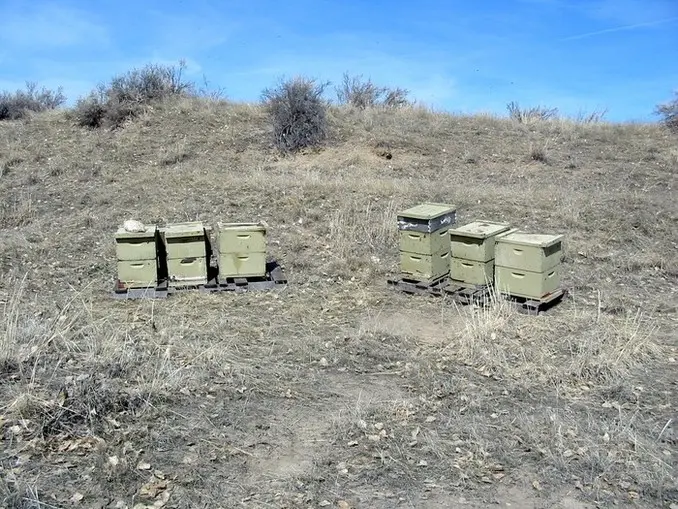Navigating the Buzz - Checker Boarding Unveiled!

-Unlocking the secrets of the un-checker board test.
Checker Boarding vs Conventional Methods: A Bee’s Tale
After a decade of faithfully checker boarding, I decided to shake things up and run a beeyard in a more conventional manner. Let me spill the honey on what went down.
Checker Boarded Yards:
- 3 deep body hives dancing in harmony since March.
- No additional feeding needed; they’re the cool cats of the yard.
- Producing honey like it’s going out of style—double the average crop!
- Less than 10% even thinking about swarming.
- Minimal inspections, minimal labor—sweet and smooth.
Conventional Yards:
- 2 deep body hives—feeding and frequent inspections galore.
- Labor-intensive days adding extra supers when polished cups appeared.
- Swarm cells playing peek-a-boo, with 90% plotting their escape.
- 25% actually taking the plunge into the swarming world.
- Swarm-prevented hives feeling a bit demoralized.
- Honey crop? Less than your average bee’s buzz.
The Yard’s New Groove:
- Shifted from 3 deep supers to 2.
- Spring feed requirements manually determined with a good ol’ heft.
- Fed honey frames to the lighter-weight hives.
- At the mere sight of polished swarm cups, a super was added on top of the brood boxes.
- Weekly check-ins on potential swarmers—bye-bye, swarm cells!
Results Are In
Swarming Chronicles:
In the conventional run, hive stats did a 180 compared to their checker-boarded glory days.
- Checker boarding: Less than 10% swarming interest.
- Without checker boarding: Over 90% had their eyes on the swarming prize.
- Broodnests were like a bustling city with rapid backfilling.
- Brood rearing hit the brakes before the first cups got their glossy shine.
Hard Work Truths:
After checker boarding for so long, I underestimated the hustle needed to prevent swarming.
- Cutting cells? Easier said than done—some sneaky ones slip through.
- Some colonies decide to skip the waiting game and swarm before a virgin even hatches.
- Others make a bold move and swarm before the queen cells are sealed!
- Despite anti-swarm efforts, 25% still took flight.
The Aftermath:
The non-swarmers weren’t exactly the MVPs either:
- Backfilled broodnests and reduced brood rearing became the norm.
- A few hives took full advantage of the extra storage space in those empty supers.
Swarmed vs. Swarm-Prevented Drama:
The contrast between hives that swarmed and those that stayed put was like day and night. Swarmed hives were the go-getters:
- Active foraging.
- Brood rearing like it’s going out of style.
- Empty supers filling up during a Yellow Sweet Clover flow.
On the flip side, the swarm-prevented hives:
- Hovered in a state of confusion.
- Backfilled broodnests with minimal rearing.
- Only a sprinkle of foraging activity.
The Head-Scratcher:
Swarm-prevented colonies didn’t gear up for swarming or winter prep—they just stood there. Nature wouldn’t stand for this indecision; it’s either swarming or winter prepping, not this in-between limbo. Maybe the frequent inspections threw a wrench into their bee plans.
Are both the parent hive and the swarm invigorated by the act of swarming? Running Russian bees once, I let the best colonies swarm without a dent in honey production.
I’m starting to think most swarm prevention methods are more disruptive than we give them credit for. Swarmed hives might’ve been better positioned for the main honey flow in July compared to their indecisive counterparts.
The Buzzkill of Conventional Beekeeping:
Pondering the downsides of conventional methods:
- Small broodnests, especially in migratory hives.
- Limited stored pollen.
- Quick depletion of honey reserves with broodnest expansion.
- Easily congested smaller broodnests leading to speedy backfilling.
This results in needy hives crying out for:
- Frequent feeding.
- Pollen substitutes.
- Swarm inspections.
- Volume management.
Up north, these activities often happen when the air is chilly, impacting colony development at a crucial time. Sometimes, the weather plays the villain, and management becomes mission impossible. Populous hives turn into damage zones when honey reserves run dry, brood expansion halts, and brood turns into a bee buffet.
In such scenarios, beekeepers become the busy bees, especially after pollinating California almonds. Corn syrup pumps humming daily, pollen substitutes filling the menu, or bees munching on brood—it’s a sticky situation.
Comparing a migratory hive to a checker-boarded, non-migratory one is a beekeeper’s journey. Post-California, migratory hives match non-migratory ones in cluster size. Fast forward two months, and the non-migratory hives are the queens of the hive kingdom. They’re 50% larger, riding the wave of three uninterrupted, low-stress brood cycles.
Meanwhile, migratory hives keep wrestling with their limited reserves and forage scarcity. Stress lingers, and bee populations dip until dandelion bloom comes to the rescue. Before that, it’s a bee drama with a slow decline.
By mid-June, a robust migratory hive is eyeing the swarming spotlight with two deeps. Contrast that with the non-migratory overwintered/checker-boarded hive, flaunting four deeps, ready to rock the honey flow.
-Bee-ing Reflective, D 🐝🤠
